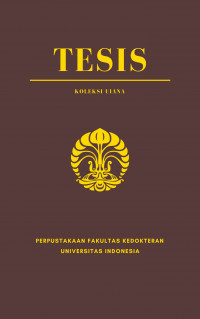Tesis
Faktor-faktor yang Mempengaruhi Kejadian Sindrom Respon Inflamasi Sistemik pasca PCNL di Rumah Sakit di Kota Medan = Factors that Influence the Incidence of Systemic Inflammatory Response Syndrome after PCNL in the Hospitals in Medan.
Pendahuluan dan tujuan: Penyakit batu saluran kemih masih menjadi penyakit terbanyak di bidang urologi. Nefrolitotomi perkutan adalah pengobatan standar untuk batu ginjal dengan ukuran > 20 mm. Komplikasi yang mungkin timbul setelah PCNL adalah demam dan urosepsis. Angka kejadian urosepsis setelah PCNL hanya berkisar 0,25% - 4,7%, namun sangat sulit untuk diobati dan dapat mengakibatkan kematian. Penelitian ini bertujuan untuk mengetahui faktor-faktor penyebab demam pasca operasi sehingga pencegahan dan deteksi dini urosepsis pasca PCNL dapat dilakukan. Metode: Penelitian ini dilakukan dengan menggunakan desain studi cross-sectional untuk data yang dikumpulkan secara retrospektif. Penelitian ini meliputi data pasien yang menjalani PCNL sejak 1 Januari 2017 hingga 31 Desember 2017 di Rumah Sakit Haji Adam Malik Medan, Rumah Sakit Columbia Asia Medan, dan Rumah Sakit Grand Medistra Lubuk Pakam Medan. Variabel yang dinilai dalam penelitian ini adalah massa tubuh. indeks, kadar leukosit sebelum dan sesudah pembedahan, ukuran batu, lokasi batu, jenis batu, ada atau tidak adanya hidronefrosis, penggunaan nefrostomi atau stent DJ sebelum pembedahan, posisi PCNL, lokasi tusukan, jumlah tusukan, lamanya waktu, pembedahan, ada atau tidak adanya batu sisa, ada tidaknya perdarahan, kadar prokalsitonin pasca operasi, dan lama rawat inap. Uji statistik yang digunakan dalam penelitian ini adalah uji regresi logistik multivariat. Hasil dianggap signifikan pada analisis bivariat jika p < 0,05. Variabel dengan p < 0,25 akan dianalisis lebih lanjut menggunakan analisis multivariat. Hasil: Terdapat 60 orang yang dilibatkan dalam penelitian ini. Dari kelima variabel tersebut, hanya ditemukan hubungan antara beberapa lokasi tusukan (p = 0,007), ukuran batu (p = < 0,001) dan jumlah perdarahan dengan kejadian pasca PCNL SIRS (p = 0,02). Dari analisis multivariat disimpulkan bahwa ukuran batu (p = 0,008) dan beberapa tusukan (p = 0,015) secara independen berhubungan dengan kejadian SIRS pasca PCNL. Kesimpulan: Terdapat beberapa faktor yang berperan atas terjadinya SIRS pasca tindakan PCNL seperti ukuran batu, durasi prosedur, jumlah perdarahan, punksi multipel, dan komorbid pasien. Pada penelitian ini didapatkan pada uji multivariat bahwa punksi multiepl dan ukuran batu berkolerasi dengan angka kejadian SIRS pasca PCNL.
Kata kunci: PCNL, urosepsis, komplikasi, multiple puncture, batu saluran kemih
Introduction and objectives: Urinary tract stone disease still the most prevalent disease in the field of urology. Percutaneous nephrolithotomy is the standard treatment for kidney stones with size of > 20 mm. Complication that may arise after PCNL is fever and urosepsis. The incidence of urosepsis after PCNL is only around 0.25% - 4.7%, but it very difficult to treat and can lead to death. This study aims to determine the factors that cause postoperative fever so that prevention and early detection of urosepsis after PCNL can be done. Methods: This study was conducted using a cross-sectional study design for data that had been collected retrospectively. This study included data from the Haji Adam Malik Hospital Medan, Columbia Asia Hospital Medan, and Grand Medistra Lubuk Pakam Hospital, Medan on patients who were subjected to PCNL from January 1 2017 to 31 December 2017. The variables assessed in this study were body mass index, leukocyte levels before and after surgery, stone size, stone location, stone type, presence or absence of hydronephrosis, use of nephrostomy or DJ stent before surgery, PCNL position, location of puncture, number of punctures, length of time, surgery, presence or absence of waste stones, presence or absence of bleeding, postoperative procalcitonin levels, and length of stay. The statistical test used in this study is the multivariate logistic regression test. Results were considered significant on bivariate analysis if p < 0.05. Variables with p < 0.25 will be analyzed further using multivariate analysis. Results: There were 60 samples included in this study. Of the five variables, only an association was found between multiple puncture sites (p = 0.007), stone size (p = < 0.001) and the amount of bleeding with the incidence of post-PCNL SIRS (p = 0.02). From the multivariate analysis, it was concluded that stone size (p = 0.008) and multiple punctures (p = 0.015) were independently associated with the incidence of post-PCNL SIRS. Conclusion: There are several factors that play a role in the incidence of SIRS, such as stone size, duration of the procedure, amount of bleeding, multiple punctures, and patient comorbidities. In this study, it was found in the multivariate test that multiepl puncture and stone size correlated with the incidence of post-PCNL SIRS.
Keywords: PCNL, Urosepsis, Complication, Multiple punctures, Urinary tract stones
- Judul Seri
-
-
- Tahun Terbit
-
2021
- Pengarang
-
Dwiki Haryo Indrawan - Nama Orang
Dhirajaya Dharma Kadar - Nama Orang - No. Panggil
-
T21079fk
- Penerbit
- Jakarta : Program Pendidikan Dokter Spesialis Urologi., 2021
- Deskripsi Fisik
-
xi, 9 hal ; ill; 21 x 30 cm
- Bahasa
-
Indonesia
- ISBN/ISSN
-
-
- Klasifikasi
-
NONE
- Edisi
-
-
- Subjek
- Info Detail Spesifik
-
Tanpa Hardcopy
| T21079fk | T21079fk | Perpustakaan FKUI | Tersedia |


Masuk ke area anggota untuk memberikan review tentang koleksi